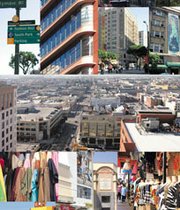City Developing Big Plans for Fashion
The Los Angeles Fashion District is on the verge of change that could transform it into the next SoHo.
That all depends on what happens with a study project set up by the Community Redevelopment Agency to figure out how the district could take the next step forward.
With $1 million in funds, the CRA last year launched an 18-month study to determine how to spruce up the 115-square-block chunk of downtown Los Angeles that is home to apparel manufacturers, wholesalers, designer showrooms, artist lofts, independent restaurants, small retail shops and the Flower Market. But it is also home to many homeless who live on the streets and to a number of down-at-the-heel hotels for the needy.
“Our hope is that it will set the vision and course for the district for the next decade,” said Kent Smith, executive director of the Los Angeles Fashion District Business Improvement District, which was established in 1996. “For such a long time, we have been this part of downtown that has been so industrial. And people haven’t taken the time or trouble to look at where the district has come from and where it is going.”
In September and October, the CRA organized seven focus groups to hear how to make the district better. The suggestions, published recently at www.fashionyourdistrict.org, were far-ranging and diverse.
Residents who live in the district’s 2,000 apartments and lofts believe more public restrooms need to be provided for the Santee Alley area. They would like to see more restaurants stay open for dinner and more spots to walk their dogs. They complained the neighborhood isn’t a very good place for bicyclists because of traffic congestion and motorists’ bad driving habits.
Owners of some of the Fashion District’s 4,000 small businesses believe the area could use a dose of public artwork to give the neighborhood a sense of identity. They also would like to see businesses stay open after 6 p.m., when many of the apparel stores and Santee Alley vendors close their doors. The district is a ghost town after dark.
More security and better lighting are ways to create a user-friendly environment and encourage customers to wander into the district, which is unfamiliar to many. Other suggestions included limiting food vendors because they hamper traffic and take up valuable parking spots, adding more public transportation to connect the area to the rest of downtown Los Angeles, improving the sewer system so that the district’s streets don’t flood when it rains, planting more trees, giving out fewer jaywalking tickets and rezoning some areas that are now deemed to be industrial zones.
With information collected from the focus groups, the CRA’s next step is to hold two public workshops in late January where anyone can share their ideas for the district.
“This is our first opportunity to engage the community at large and hear directly from them about what they want the district to be in the next generation or two,” said Gaurav Srivastava, the project manager for the studies. He works for Aecom, a multi-faceted company that received the $1 million CRA contract to conduct the Fashion District studies and make recommendations.
Srivastava said the first public workshop will be held from 6 to 8 p.m. on Jan. 27 at the Cooper Design Space, located at 860 S. Los Angeles St., or a nearby building. Final location plans haven’t been shored up yet. Another workshop is scheduled for 10 a.m. to noon on Jan. 29 at the same to-be-determined spot.
Next summer, Aecom will hold more public workshops to talk about the results from the previous workshops.
Private vs. public
For the most part, any changes within the Fashion District have come from private investors who have converted old manufacturing sites—or built new structures—to house more apparel showrooms and residential compounds.
Even the Los Angeles Fashion District, organized to make the area clean and safe, operates on a $4.2 million budget paid for by 950 different property owners and stakeholders in the area. It was the first property-owned BID in the city and takes up 20 percent of downtown Los Angeles.
But now the city is turning its eye to this neighborhood and wondering how it can connect to the vibrant and popular Staples Center entertainment district and lure more people from the upper-crust Financial District near Bunker Hill.
Both those neighborhoods underwent a major transformation with the CRA, which helped acquire property for the Staples Center and for high-rises in the Financial District. The CRA receives its financing from the higher property taxes generated in its redevelopment zones.
Jenny Scanlin, the CRA project director for the Fashion District, said the CRA will have a clearer vision of what can be done in the district once the studies are tabulated and a report is made by the end of 2011 or early 2012.
But already she has some tentative ideas. She envisions developing a park in the Fashion District that would take on the same tenor as New York’s Bryant Park, where New York Fashion Week was held before it moved this year to Lincoln Center. “We could have fashion shows and do night markets,” she said, noting there were several city-owned pieces of property that would make good parks.
“We could bring more residential back into the district when the [real estate] market comes back, more restaurants and nightlife so it has a connection to all the activity that is happening near Staples Center, the Historic Core and the Art Walk.”
Other ideas include developing the retail potential of Los Angeles Street. “We think Los Angeles Street needs to find itself,” Scanlin explained. “We think Los Angeles Street can be repositioned into a boutique street with some really interesting restaurants and street life going on that is complementary to the Fashion District.”
Other suggestions include linking the district to the Red Car trolley proposed by City Councilman Jose Huizar, which will run up and down Broadway in the Fashion District.
The CRA would also like to find another use for the 196-unit Huntington Hotel, a troubled, low-income residential spot built in the early 1900s at Eighth and Main streets.
Preserving fashion
While everyone agrees it is good to have the CRA take a look at the Fashion District with “new eyes,” no one wants to see the district’s unique fashion flavor disappear.
“I want them to maintain the focus of the Fashion District,” said Ilse Metchek, a former dress designer and manufacturer and now president of the California Fashion Association, a Los Angeles–based industry trade group. She envisions seeing small manufacturers, wholesalers and showrooms preserved rather than an infusion of more artist lofts.
Ethan Eller, general manager of The New Mart in the heart of the Fashion District, believes his building, built in 1928, is perfect in its role as a home for showrooms. However, he would like to see more free parking in the district.
And Steve Hirsh, who owns the Cooper Design Space and whose father was a garment manufacturer, pointed out there are a lot of good things going on in the district. Those good things should be preserved. “I said they should use the fashion industry as an anchor going forward,” he said. “We should keep the district creative and in fashion.”
























